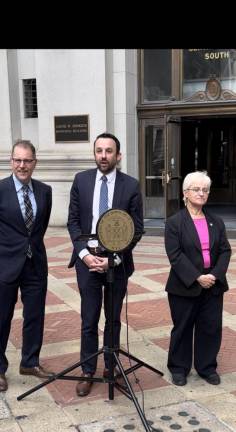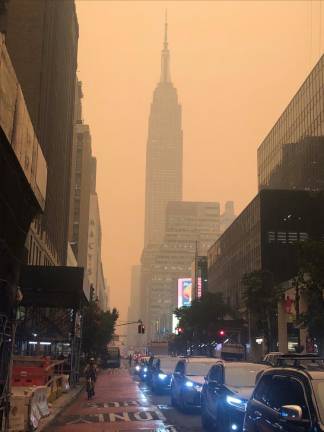After Orange Skies, Keith Powers Introduces Indoor Air Quality Bills At Mark Levine’s Request
New York City Council Member Keith Powers has introduced a spate of bills that aim to standardize healthy indoor air quality through diligent monitoring and reporting, at the request of Manhattan Borough President Mark Levine. The legislation corresponds to four distinct indoor spaces that New Yorkers tend to congregate in: public schools, commercial buildings, residential buildings, and municipal or “city” buildings. He gave an overview of the bills during a press conference in front of the Manhattan Municipal Building on Thursday, July 13th, where he received endorsements of the laws from Levine, Health Committee Chairperson Member Lynn Schulman, and Hospital Committee Chairperson Mercedes Narcisse.
Keith Powers has introduced a set of new bills with the intention of standardizing indoor air quality for New Yorkers, with four pieces of legislation covering four prevalent building types: public schools, commercial buildings, residential buildings, and municipal buildings.
The District 4 Council Member represents a stretch of Manhattan ranging from Midtown East to Stuy Town to the UES, but in a press conference in front of the Manhattan Municipal Building at 1 Centre St., he clearly hoped to speak for all city residents. It was a gray and somewhat dreary morning, but considering that the topic animating the proceedings was the need to do something about the orange skies NYC saw last month, it was certainly preferable weather.
Reflecting on that chaotic week brought about by drifting wildfire smoke from Canada, Powers noted that “not surprisingly, we all sought refuge indoors, which makes sense. We spent about 90 percent of our time indoors as human beings.” According to him, however, this was an imperfect solution. “You can’t take indoor air for granted either. We often have no idea what’s in the air that we’re breathing, how clean the air is, how much particulate matter is it in, and [if it’s] been filtered for viruses or other things that harm us,” he continued, in what he clarified should be an obvious reference to the pandemic. Putting away his prepared remarks, Powers added that he “personally believes that this is an issue that we are ignoring nationwide.”
Borough President Mark Levine was on hand and he began his commentary with a little history lesson, remarking that around 50 years ago “we began to hermetically seal our buildings. I’m not really sure what the thinking was, but when COVID hit, man did we pay a price for that!”
Now that the pandemic has waned, Levine said he believes there are new incentives for achieving proper indoor circulation, with the recent bout of orange smog serving as a wake-up call. “I might not be able to open the windows up on the 19th floor—they’re pretty tightly sealed—but I felt the smoke from Canada inside my office that day,” he quipped (Levine works out of 1 Centre St.). Seemingly addressing the assembled press corps, he claimed that better circulation leads to better working conditions and that “you probably know this intuitively.” Backing up Power’s sentiment that indoor air quality was a “nationwide” problem, Levine mentioned that he’d been on the phone with Ashish Jah–who served as the Biden administration’s “COVID czar” until recently–to discuss the matter and what NYC politicians were hoping to do about it.
Lynn C. Shulman, the chair of the Health Committee on the Council and the representative for District 29 in Queens, used her time at the podium to make the link between the wildfire smog and climate change. “Everybody sees all the heat domes across the country,” she stated, and warned New York to brace for more knock-on air quality effects as a result.
Mercedes Narcisse, the chair of the Hospital Committee and the City Council representative for Brooklyn’s 29th District, stepped up to the mic to express that she had high hopes for the legislation. As she put it, “when we came [outside] and saw our skies were orange, it was a panic time for us. The folks we’re supposed to represent the most—we serve underserved communities—peoples that have more problems to deal with in their lives, so if we can alleviate that, why not?”

